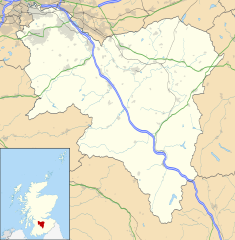Lee Castle, South Lanarkshire
| Lee Castle | |
|---|---|

Lee Castle drawn in 1830 by John Preston Neale
|
|
| Coordinates | 55°41′54″N 3°49′29″W / 55.6984°N 3.8247°WCoordinates: 55°41′54″N 3°49′29″W / 55.6984°N 3.8247°W |
|
Listed Building – Category B
|
|
| Designated | 12 January 1971 |
| Reference no. | 13056 |
| Designated | 1987 |
Lee Castle, also known as The Lee, is a castellated mansion in Auchenglen, a branch of the Clyde Valley in South Lanarkshire, Scotland. It is located 1.5 kilometres (0.93 mi) south of Braidwood, and 4 kilometres (2.5 mi) north-west of Lanark. Lee was the seat of the Lockharts of Lee from its establishment in the 13th century until 1919, though the present house is the result of rebuilding in the 19th century.
The house is protected as a category B listed building, and the grounds are included in the Inventory of Gardens and Designed Landscapes in Scotland, the national listing of significant gardens.
In 1272, William Locard was granted the feudal barony of Lee. His son, Sir Simon Locard (1300–1371), fought in the Wars of Scottish Independence, and afterward accompanied Sir James Douglas in his attempt to carry the heart of Robert the Bruce to the Holy Land in 1330. Following the death of Sir James Douglas in battle with the Moors in Spain, Sir Simon carried the Bruce's heart back to Scotland for burial at Melrose Abbey. He is said to have subsequently added the heart and fetterlock to the family coat of arms. He also acquired the "Lee Penny", an amulet or touch piece said to have healing properties, and which remains in the family's possession.
Sir William Lockhart of Lee (1621–1675) fought for the Royalist cause in the English Civil War, but switched sides, and later married the niece of Oliver Cromwell. Lockhart was appointed Cromwell's commissioner for the administration of justice in Scotland, in 1652. He also served as English ambassador at the French court in 1656. His brother George Lockhart was appointed Lord Advocate, and he purchased the Lanarkshire estates of the Earl of Carnwath. Both Lee and Carnwath estates were inherited by his son Sir George Lockhart of Lee (1673–1731). He acted as a commissioner for the Act of Union between England and Scotland in 1707, but later adopted the Jacobite cause. He was involved in the Jacobite Rising of 1715 but escaped serious punishment. George's grandson, another George, fought with the Jacobites in the 1745 Rising, and afterwards went into exile. This George's younger brother also went overseas, fighting in the Austrian army during the Seven Years' War. He inherited the Lee estates by staging the death of his traitorous older brother, and was made a Count of the Holy Roman Empire in 1782. His nephew, Alexander Lockhart of Lee, member of Parliament for Berwick-upon-Tweed, was made a baronet in 1806.
...
Wikipedia

